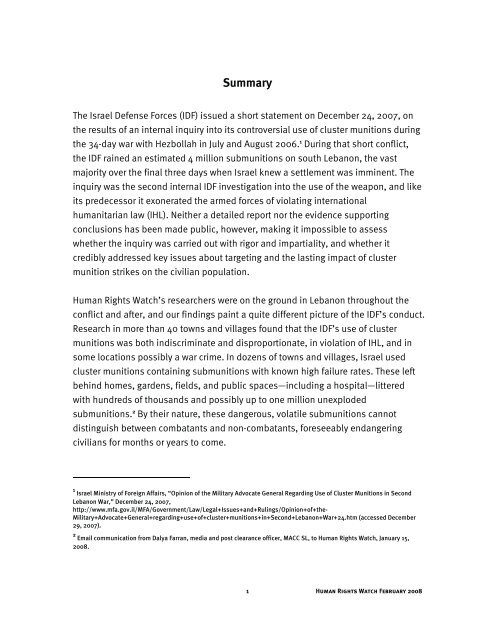Flooding South Lebanon - Human Rights Watch
Flooding South Lebanon - Human Rights Watch
Flooding South Lebanon - Human Rights Watch
You also want an ePaper? Increase the reach of your titles
YUMPU automatically turns print PDFs into web optimized ePapers that Google loves.
Summary<br />
The Israel Defense Forces (IDF) issued a short statement on December 24, 2007, on<br />
the results of an internal inquiry into its controversial use of cluster munitions during<br />
the 34-day war with Hezbollah in July and August 2006. 1 During that short conflict,<br />
the IDF rained an estimated 4 million submunitions on south <strong>Lebanon</strong>, the vast<br />
majority over the final three days when Israel knew a settlement was imminent. The<br />
inquiry was the second internal IDF investigation into the use of the weapon, and like<br />
its predecessor it exonerated the armed forces of violating international<br />
humanitarian law (IHL). Neither a detailed report nor the evidence supporting<br />
conclusions has been made public, however, making it impossible to assess<br />
whether the inquiry was carried out with rigor and impartiality, and whether it<br />
credibly addressed key issues about targeting and the lasting impact of cluster<br />
munition strikes on the civilian population.<br />
<strong>Human</strong> <strong>Rights</strong> <strong>Watch</strong>’s researchers were on the ground in <strong>Lebanon</strong> throughout the<br />
conflict and after, and our findings paint a quite different picture of the IDF’s conduct.<br />
Research in more than 40 towns and villages found that the IDF’s use of cluster<br />
munitions was both indiscriminate and disproportionate, in violation of IHL, and in<br />
some locations possibly a war crime. In dozens of towns and villages, Israel used<br />
cluster munitions containing submunitions with known high failure rates. These left<br />
behind homes, gardens, fields, and public spaces—including a hospital—littered<br />
with hundreds of thousands and possibly up to one million unexploded<br />
submunitions. 2 By their nature, these dangerous, volatile submunitions cannot<br />
distinguish between combatants and non-combatants, foreseeably endangering<br />
civilians for months or years to come.<br />
1 Israel Ministry of Foreign Affairs, “Opinion of the Military Advocate General Regarding Use of Cluster Munitions in Second<br />
<strong>Lebanon</strong> War,” December 24, 2007,<br />
http://www.mfa.gov.il/MFA/Government/Law/Legal+Issues+and+Rulings/Opinion+of+the-<br />
Military+Advocate+General+regarding+use+of+cluster+munitions+in+Second+<strong>Lebanon</strong>+War+24.htm (accessed December<br />
29, 2007).<br />
2 Email communication from Dalya Farran, media and post clearance officer, MACC SL, to <strong>Human</strong> <strong>Rights</strong> <strong>Watch</strong>, January 15,<br />
2008.<br />
1<br />
<strong>Human</strong> <strong>Rights</strong> <strong>Watch</strong> February 2008
















